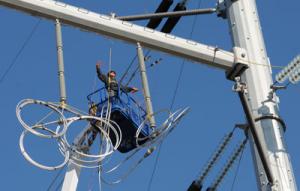Transmission Rate Incentives
FERC’s move might appear calculated to send a message to the power industry.

The Federal Energy Regulatory Commission (FERC) in mid-October granted a trimmed-down set of rate incentives for the proposed $1.6 billion RITELine transmission line project. The action prompted a dissenting opinion from Commissioner Philip Moeller, who suggested that the commission perhaps was jumping the gun on making reforms to its Order 679 framework on transmission rate incentives, rather than waiting to act through its pending Notice of Inquiry, in which FERC this year has been taking comments on how best to update and improve the now-five-year-old policy.
"Now is not the time," Moeller wrote, "for this commission to begin retreating from its incentive policy on needed transmission lines."
"Yet I question," he added, "whether we are sending that message."
Moeller was pointing specifically to the commission’s decision to trim 50 basis points from the 150 basis-point rate-of-return (ROE) adder that the RITELine developers had proposed to recognize the "risks and challenges" inherent in developing the 420-mile, 765-kV line, which is designed to strengthen the transmission grid in Illinois, Indiana and Ohio, and to permit the integration of approximately 5,000 MW of added renewable wind generation into western PJM. (RITELine Illinois LLC, FERC Docket Nos. ER11-4069, ER11-4070, issued Oct. 14, 2011, 137 FERC ¶61,039.)
In its order, issued Oct. 14, FERC had OK’d various other rate incentives proposed by the developers for the project, including A) 50 basis points for joining a Regional Transmission Organization; B) rate base treatment for 100 percent of construction work in progress (CWIP), C) guaranteed rate recovery in event of a no-fault project abandonment, and D) a hypothetical 45/55 debt-equity capital structure.
But as each of those incentives, taken in turn, would likely mitigate overall project risk, FERC found it appropriate to scale down the primary ROE adder:
"We are reducing the … requested 150-basis-point adder to 100 basis points in consideration of the total package of incentives conditionally granted in this order.
"We find," FERC explained, "that granting 100 basis points is just and reasonable in light of the other incentives that the commission is conditionally granting the RITELine Companies herein, some of which reduce certain financial and regulatory risks that the RITELine Companies cite as support for a 150-basis-point incentive ROE adder."
Many PUCs wonder why transmission line developers should be paid rate incentives for ensuring reliability, when transmission providers are required to do that anyway.
In fact, FERC’s move might well appear calculated to send a message to the power industry. The Notice of Inquiry features some 75 questions seeking ideas for policy reform — several of which seem to describe the very same issue involved in the RITELine case:
- QUESTION 27: Are there specific criteria the commission should use in evaluating whether an how to adjust certain incentives to account for the impacts of other incentives?
- QUESTION 28: Do certain incentives sufficiently mitigate the risks and challenges of a transmission project so as to obviate the need for granting other incentives, or warrant adjustment in the level of those incentives? For example, should granting 100 percent CWIP and recover of the costs of abandoned plant affect the evaluation of a request for an incentive ROE adder based on a project’s risks and challenges?
- QUESTION 41: Does regulatory assurance of cost recover … mitigate the risks and challenges facing a transmission project? If so how should the commission give consideration to this mitigation in evaluating a request for [an] incentive ROE adder based on a project’s risks and challenges? (See, Promoting Transmission Investment through Pricing Reform, Notice of Inquiry, FERC Docket RM11-26, issued May 19, 2011.)
The Pending Reform Effort
FERC Order 679, crafted in 2006 to comply with Sec. 1241 of the Energy Policy Act of 2005 (Federal Power Act sec. 219), awards rate incentives only for those transmission projects that either ensure reliability or reduce the cost of delivered power by reducing transmission line congestion. Parties seeking incentives can claim a rebuttable presumption that their projects meet one of those two goals if they win approval for their project under a fair, open and transparent regional transmission planning process. If not, they can present independent evidence of reliability or economic benefits, or show they have obtained siting or permitting authority from relevant state agencies. (See, Order 679, Docket No. RM06-4, July 20, 2006, 116 FERC ¶61,057.)
Nevertheless, in cases where the rebuttable presumption does not apply, FERC has tended to go ahead and approve incentives — but then make the award conditional upon project approval by a regional transmission planning group (as it did in the RITELine case).
Also, the issues involved in Order 679 and its possible reform are of particular significance to state public utility commissions. As of mid-September at least 19 state PUCs had filed comments in FERC’s Notice of Inquiry — plus many other PUCs that joined in comments filed by regional state committees, including the New England Council of Public Utility Commissioners, the Southwest Power Pool Regional State Committee, and the Organization of MISO States. Many state PUCs also have joined comments filed by the American Public Power Association and various public interest groups, which have questioned FERC’s Order 679 policy for years. They wonder, for example, why transmission line developers should be paid rate incentives for ensuring reliability, when transmission providers are required to do that anyway. They have also complained that FERC’s interpretation of the Order 679 "nexus" requirement — the duty to prove that a project is not routine — simply does not raise the bar high enough.
Project & Incentives
The Reliability Interregional Transmission Extension (RITELine) project is being developed by 1) American Electric Power, 2) Commonwealth Edison, 3) Electric Transmission America (ETA, a joint venture between AEP Transmission Holding Co. [ATHC] and MidAmerican Energy Holdings Co. America Transco), and 4) RITELine Transmission Development (RTD, comprised of both ETA and Exelon Transmission Co. (See the map and project narrative at Exelon's website).
FERC explained that RITELine’s proposed reasonable ROE range (7.2 was too wide because it wrongly included a statistical outlier.
The public utility operating companies of the project will be RITELine Illinois (75 percent owned by ComEd) and RITELine Indiana (owned by RTD [25 percent], ATHC [37.5 percent] and ETA [37.5 percent]).
As of the date of the order, the project developers had not yet won approval from any regional transmission planning group. Also, they had failed to convince FERC sufficiently of that the project would enhance reliability or mitigate congestion, despite having won endorsements of those two points from two ad hoc transmission planning studies: the Strategic Midwest Area Transmission (SMART) Study, and the Midwest Independent System operator (MISO) Regional Generator Outlet Study (RGOS).
Nevertheless, FERC said it could still award incentives by making them conditional on an eventual project approval by PJM, with inclusion of the project in PJM’s Regional Transmission Expansion Plan (RTEP) — a strategy that FERC has employed before in approving many of the 75 or more applications for transmission rate incentives in the five-plus years since adopting Order 679.
The RITELine decision is noteworthy also for two other points.
First, the order denied in its entirety a proposed 50 basis-point ROE adder for use of advance technology (the use of a six-conductor bundle in conjunction with trapezoidal stranded conductors), as FERC found that such technology was currently in use, and had been so "for some time."
Second, the decision trims the basic, underlying ROE for the project from 10.7 percent, as requested by the developer, to 9.93 percent. FERC explained that RITELine’s proposed reasonable ROE range (7.2 to 15.0 percent) was too wide because it wrongly included a statistical outlier. By eliminating the high- and low-end extremes, FERC reached a narrower range of 7.15 to 13.65 percent. Starting from the median of 9.93 percent, FERC authorized an overall ROE of 11.43 percent — 9.93 percent plus 150 basis points in ROE adders under the Order 679 policy.
ABOUT THE AUTHOR: Bruce W. Radford is publisher of Public Utilities Fortnightly magazine, and covers FERC regulation in the monthly "Commission Watch" column. This article was adapted from a story that appeared in Utility Regulatory News #4042, Oct. 21, 2011.



